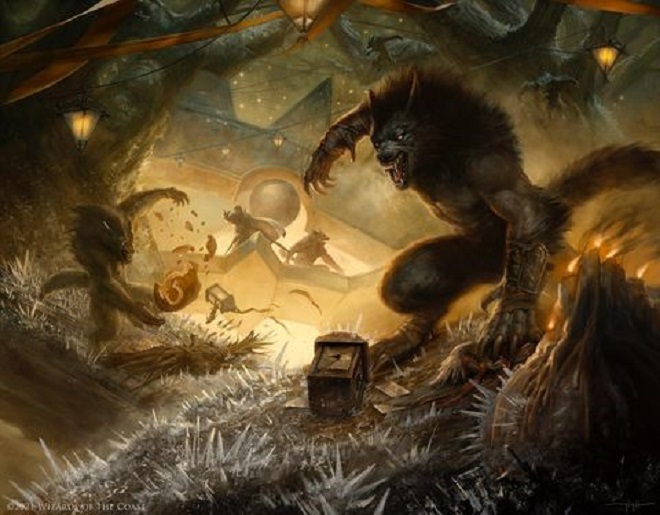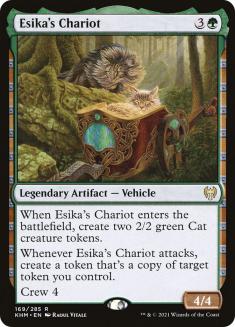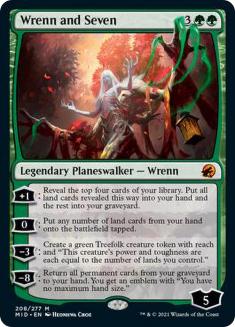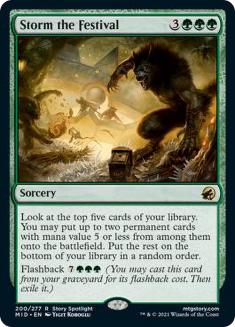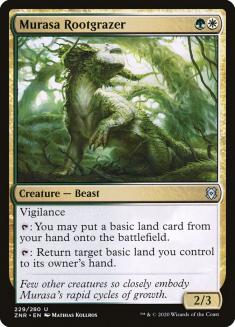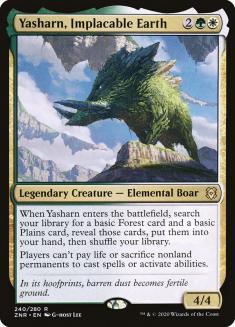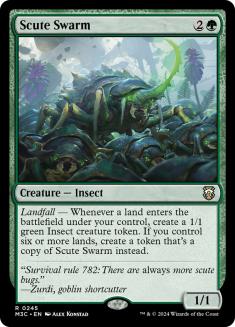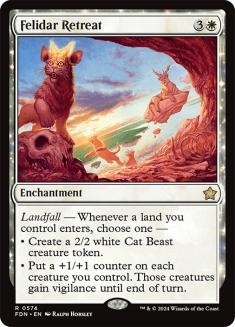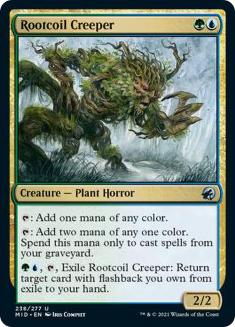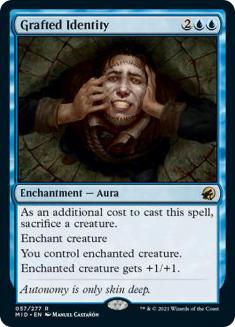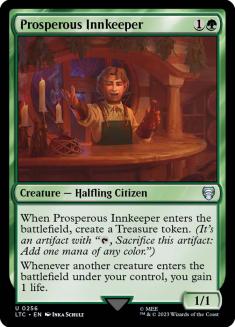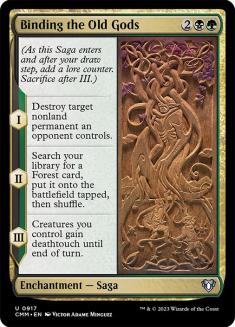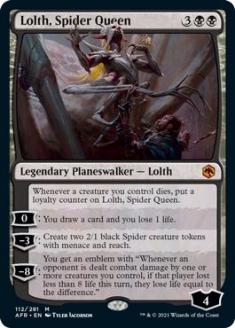Standard is still pretty new and fresh, but at this point we’ve had a couple of cores solidifying themselves as pillars of the format. One of those is the Izzet shell (either Dragons or Turns), another is the Blood in the Snow shell (either Mono-Black or with a second color), and the third, and by far the biggest, is the Esika’s Chariot + Wrenn and Seven shell.
There are many different decks that play those two cards in combination, on all parts of the metagame spectrum. It’s easy to see why — both cards are individually powerful and, very importantly, work on both offense and defense. If you’re on the back foot, then they produce a number of very solid blockers, and if your opponent is stumbling, they can close out the game very quickly. Then, of course, there’s the one-two punch of Esika’s Chariot followed by Wrenn and Seven, where you make a Treefolk, use that to crew the Chariot, and then copy the Treefolk upon attacking.
Another card that combos extremely well with those two is Storm the Festival, as they are exactly the sort of permanents you’d like to put onto the battlefield for free. Together, these three cards will form the core of every deck I’m writing about today.
When Storm the Festival was first released, I sort of dismissed it as a gimmicky card — it looked too expensive for something that was sorcery-speed and just overall not worth the trouble. I believe I was wrong for two main reasons:
The supporting cast behind this card is incredibly strong. In some formats, there wouldn’t be that much worth hitting, but here we can hit a multitude of cards that we’re naturally trying to include in our deck anyway because they’re so individually strong and just happen to cost four or five.
Storm the Festival has flashback. For most cards, ten mana is a pipe dream — so much so that I basically ignored it when I first read the card. For Storm the Festival, it isn’t. With Collected Company, if you brick, then that’s it — you’re done. With Storm the Festival, “bricking” is putting two more lands on the battlefield, which gets you that much closer to flashing back Storm the Festival. On top of that, Wrenn and Seven is excellent at finding lands seven through ten, and it mills Storm the Festival in the process. Flashing back this card is actually quite common in most Storm the Festival builds, rather than the happenstance I thought it was going to be.
That said, there are many different ways of building Storm the Festival decks. Today, I’m going to examine the different versions of the deck and their pros and cons.
Generally speaking, all of those decks have the pro that they’re quite powerful — you’re capable of going over the top of many strategies and your cards are individually strong. If you’re in a topdeck war, for example, you’re almost certainly going to win with a Storm the Festival deck.
They also all share the general con that they’re ramp decks, and as such need to draw their cards in roughly the right order. If you draw the cheap cards and accelerants early, your deck is going to look phenomenal, but if you draw a lot of expensive cards early or a lot of accelerants late, your deck might become non-functional. These two things are constant across all builds and will vary only a little depending on which ones you play, but they’re usually a trade-off (the more powerful your deck is, the more inconsistent it’s going to be as well).
Selesnya Festival
Creatures (21)
- 4 Murasa Rootgrazer
- 4 Skyclave Apparition
- 3 Tangled Florahedron
- 4 Yasharn, Implacable Earth
- 3 Scute Swarm
- 3 Prosperous Innkeeper
Planeswalkers (4)
Lands (10)
Spells (25)

The list above is from Magic Online (MTGO) user Brian_Kibler_is_God (nice try Brian Kibler).
Selesnya Festival decks are the most “land-based” of them all, including cards such as Scute Swarm and potentially Felidar Retreat. They use the incredibly underrated and also incredibly-annoying-to-use-correctly-on-Magic-Arena Murasa Rootgrazer as a way to fuel its landfall triggers, and it’s the best deck at actually making use of all the lands you get from Wrenn’s +1 ability since you can play multiples in a turn. There are some other versions of the deck that include both green and white and could theoretically play Murasa Rootgrazer as well, but its ability only works with basic lands so it needs to be played in straight-up Selesnya to have any effect.
Another card I really like in this deck is Yasharn, Implacable Earth. A 4/4 for four mana is reasonable stats, and with Murasa Rootgrazer you can make good use of the extra lands it gives you. Importantly, the ability is also randomly relevant against things like Treasures from Goldspan Dragon.
Personally, I would play four Storm the Festival on this list. I think the Selesnya deck makes very good use of this card because it actively wants to hit extra lands some of the time, and it has a lot of mana so flashing it back is not that hard.
The biggest pro of this deck is that, when it goes off, it goes off really hard. Scute Swarm is able to go over the top of any creature deck, and if two relatively uninteractive decks are facing each other, then it will simply win you the game. The Selesnya version, for example, will usually crush the Bant version on the strength of this card alone. If you play Felidar Retreat, it even gets magnified.
The biggest con of this deck is that sweepers are quite common right now, and that’s a big part of your end-game. Cinderclasm is routinely maindecked, as are Blood in the Snow and The Meathook Massacre. This means that sometimes you go off super-hard and still don’t really accomplish anything.
The second con is that your sideboard is not well-equipped for decks that are not creature-based — most of it is removal and then you have some learn targets for Field Trip. Reidane, God of the Worthy is a good card here, but you’re not applying a whole lot of pressure, and something like Izzet Turns can simply go over the top of you because you don’t have access to any disruption.
Simic Festival
Creatures (18)
- 4 Tangled Florahedron
- 4 Prosperous Innkeeper
- 2 Iymrith, Desert Doom
- 4 Briarbridge Tracker
- 4 Rootcoil Creeper
Planeswalkers (4)
Lands (12)
Spells (26)

The above list is by a Brazilian streamer called Sandoiche.
The straight-up Simic version is a bit more on the fair end of the spectrum than the Selesnya version, which is the most “rampy” of them all in my opinion. The general idea is the same, but you also have Iymrith, Desert Doom as something else to accelerate into that acts as a powerful mid-game threat.
There are two interesting cards here that combo quite well with Storm the Festival: Rootcoil Creeper and Grafted Identity.
Rootcoil Creeper is, in my opinion, the best card to enable Storm the Festival. Adding two mana when you’re flashing back spells is huge, and goes a long way towards reaching the ten-mana threshold that you need. Consider a scenario in which you have five lands and a Rootcoil Creeper — this allows you to cast Storm the Festival from your hand. Now, imagine you hit a second Rootcoil Creeper and then a land. This is considered a miss in almost every scenario, but with six lands and two Rootcoil Creepers, that’s already enough to flashback Storm the Festival the very next turn!
More than that, the third ability on Rootcoil Creeper comes up fairly often. This deck has a lot of mana sources, so in the late-game it’s not uncommon to sacrifice Creeper to put Festival back into your hand, and it acts as the exact same as drawing another Festival, since you get to cast it two more times. Being able to cash in your two-mana accelerant for your ten-mana threat in the late-game is an absurdly good proposition.
The second card, Grafted Identity, is interesting because it requires a sacrifice as a cast trigger, which means if you get it onto the battlefield from Storm the Festival, it completely bypasses that clause and acts as a Control Magic that gives the creature +1/+1. I also like that the card helps justifying the inclusion of Prosperous Innkeeper, which I’ve struggled with in these Festival decks to some extent.
On the surface, I understand why people play Prosperous Innkeeper; it’s nice to have an accelerator that they can’t just kill. A lot of the time people will hit your Rootcoil Creeper or Tangled Florahedron with Play with Fire, Portable Hole, or Bloodchief’s Thirst, and then you might not even have a Turn 3 play because these lists aren’t constructed with that in mind. A lot of the time, the best you can do is another accelerant, but often not even that. With Prosperous Innkeeper, your ramping is almost guaranteed to work, and you can gain some life on top of it, which can be valuable versus aggro decks.
The problem with the card is twofold. The first is that the deck is trying to accelerate to more than one card — it’s not full of four-drops either. So you can go Turn 2 Innkeeper and use the Treasure to facilitate a Turn 3 Esika’s Chariot, but what do you do on Turn 4? The natural curve in the deck is Chariot into Wrenn and Seven into Storm the Festival, but you’ve already used your Treasure, so you can’t do that. You’re getting Chariot onto the battlefield a turn sooner, which is huge, but you’re not accelerating your gameplan by an entire turn the way you would be doing with a regular mana accelerator.
The second problem is that the deck is not using the 1/1 body very well. Something like Naya Winota in the past format, for example, actively wanted the 1/1 as an attacker. Some of the Golgari-based decks can use it as fuel for various sacrifice effects, from Skullport Merchant to Deadly Dispute. The Storm the Festival decks aren’t really doing anything with it other than chump-blocking, and that’s where Grafted Identity comes in. So the Simic version of the deck does not solve the first problem, but it does solve the second one and means the Innkeeper provides you more value.
In the sideboard, we can see that we have the opposite problem compared to the Selesnya version. This version is full of cards against control decks but we don’t have enough against aggro. Unfortunately, there just isn’t that much in this color combination that’s effective.
Bant Festival
Creatures (24)
- 2 Lotus Cobra
- 4 Tangled Florahedron
- 3 Glasspool Mimic
- 3 Elite Spellbinder
- 1 Prosperous Innkeeper
- 3 Mind Flayer
- 4 Brutal Cathar
- 4 Rootcoil Creeper
Planeswalkers (4)
Lands (22)
Spells (10)

Bant Festival is the most “midrange” of the archetypes; it’s running a lot of enters-the-battlefield triggers and trying to play a normal game of Magic with Storm the Festival as a plus. Cards like Elite Spellbinder, Brutal Cathar, and Mind Flayer, as well as sideboard Reidane, God of the Worthy, enable you to behave as a normal midrange deck that can threaten the opponent’s life total and pressure them to act. The list above is Brad Nelson’s and you can read more in depth about it in his article earlier this week.
These elements make it the least powerful deck, but also the most consistent, because the cards aren’t that reliant on each other and work in more spots on the curve (Brutal Cathar can be your Turn 3 play or your Turn 6 play with similar efficiency a lot of the time). This is reflected in the number of Prosperous Innkeepers the list is playing — only one. Here, it’s not as important that you accelerate from two to four, because the deck has a lot of three-drops as well. Instead, the deck prefers the more constant acceleration from Lotus Cobra, and, if they kill it on Turn 2, you can just cast Elite Spellbinder or Brutal Cathar instead.
The sideboard is basically the combination of the anti-aggro cards from Selesnya and the anti-control cards from Simic, which means you actually have the tools to improve your deck against everything. In his article, Brad mentioned that the deck doesn’t have a great sideboard and that Bant decks rarely do, bu he must be spoiled by some pretty great sideboarding strategies from other decks, because in my opinion this is a notch above what we usually see, and definitely much better than the previous two decks.
Sultai Festival
Creatures (12)
Planeswalkers (4)
Lands (22)
Spells (22)

I credited this deck to crokeyz because he was the first person I saw playing it, but I don’t know whether he built the deck or not (though, as Andrea Mengucci would say, everything you see is crokeyz’s list.
The Sultai version of the deck is the most reactive of them all, and it behaves similarly to the Simic version with some extra perks. Every deck here is a tap-out, and no one is trying to play draw-go, gain absolute control of the game, or counter everything the opponent is playing. That said, all the other versions have proactive plans and are trying to bury the opponent with Storm the Festival, whereas this version has a lot more reactive cards and is even playing several maindeck sweepers. With four copies of Alrund’s Epiphany, it has the ability to go over the top of the other slow decks as well, and it plays almost like a combo deck in some sense. It still has Esika’s Chariot and Wrenn and Seven, though, so it’s definitely capable of pressuring the opponent with some of its draws.
The Selesnya deck will go over the top of any deck with just creatures (e.g. Mono-Green Aggro), but the Sultai deck will go over the top of decks with sweepers because of four copies of Alrund’s Epiphany. In return, you’re paying a big cost, because the last thing that your deck that relies on a six-mana sorcery that needs five-mana permanents needs is a seven-mana spell that doesn’t interact with them in any way (it would be different if you could hit it off Storm the Festival).
On top of that, having removal spells can be a blessing and a curse. It’s important to be able to kill some creatures, and the ability to reset the battlefield cannot be understated in a slow deck, but ramp decks are usually binary in what they have — you have the accelerants and the things to accelerate into, and you need to draw both in reasonable amounts. If you add in a card like Infernal Grasp, that’s neither piece of the puzzle, so it increases the chances you’ll have a non-functional draw. Binding the Old Gods gets to play double-duty, though, on top of being hittable by Storm the Festival, and I think that’s the main reason to play black.
The main change I would make would be incorporating Lolth, Spider Queen into the deck. This card has been very impressive and it’s a perfect hit off Storm the Festival. I think taking out two Epiphanies for two Lolths will maintain the over-the-top nature of the deck while increasing its power in the mid-game, where it’s currently lacking (you don’t need to go that hard on Epiphanies to accomplish what you want). I would also remove the Skyclave Shades from the sideboard because you’re not really interested in beating down. Shade is going to deal twelve damage and then you’ll be unable to deal the other eight; instead, I’d play a disruption spell of some sort (either discard or counterspells).
Which One Is Best?
So, when all is said and done, which version of the deck would I play? I think that, as a general rule, the Bant list is the most consistent for a wide field, because I really like the ability to just play a regular game of Magic, and none of the other versions have much of that, so it’s my pick for best Festival list. However, I also think the Bant list suffers from people going over the top of it — the price it pays for having a lot of three-drops is that those are not seven-drops, and the three-drops aren’t winning the game in the mirror. If I didn’t expect a lot of mirror-esque decks, then I’d play Bant. Otherwise I’d play Sultai.
In general, I would stay away from both the Selesnya and the Simic versions at this point. The Selesnya version is too weak to sweepers in general, and the Simic version strikes me as a slightly weaker version of the Sultai deck. I haven’t found the mana to be a big problem in either of the tricolored versions (though it is better in Bant). I do think both the Bant and the Sultai lists have the ability to compete in this format, depending on what field you expect, and I’ve also honestly found Storm the Festival a lot more fun than Collected Company ever was, so if you’re on the fence, you should give these decks a try.

